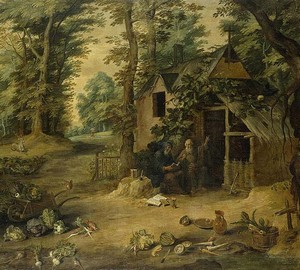
Description of the picture:
Meeting of Saints Anthony the Great and Paul the Hermit – David Teniers the Younger. Wood, oil. 97.3×157.5
St. Anthony the Great, or Abbot Atony (c. 251/52 – 356), born in Upper Egypt; after the death of his parents, he retired to the desert. Pavel the Hermit, or Pavel Thebansky (d. 341) – the first desert of Egypt, who lived in the vicinity of the city of Thebes. Both Christian saints are known as great hermits. Although they were born and raised in wealth, both left their home to lead a lonely and pious life. At the age of 90, St. Anthony, according to legend (LA, XV), went to search for the hermit Paul, who was then 113 years old, in the Theban desert.
Meeting of Saints Anthony and Paul became a common plot in Western European painting of the XVII century. One of the most famous examples is the painting of the same name by Velazquez, in which the meeting of two saints is supplemented by an episode of the burial of Paul the Hermit. In the interpretation of landscapes on the canvases of Velazquez and Teniers of the 1630s, a similarity is observed due to the influence of Flemish landscape painting of the 16th – early 17th centuries, in particular paintings by Joachim Patinir and Ios de Momper the Younger.
Teniers several times turned to two main subjects from the life of St. Anthony. For example, in the mid 1640s, he created the painting “The Temptation of St. Anthony ”, in the background of which among the rocks you can see the tiny figures of two shot, Atony and Paul. A raven flies towards them, holding bread in its beak, which, by the command of God, he fed Paul. On the Hermitage canvas, the meeting of two saints is not secondary, but the main plot. It depicts large figures of saints sitting in front of a hut and conducting a conversation. St. Anthony is represented in a traditional black mantle, and St. Paul is in a robe of leaves. In one hand he holds a staff, with the other – we point to the roof of the hut, where a cross and a raven with bread are visible. On the ground, next to the characters, are an hourglass, reminiscent of the transience of earthly life. Similar in interpretation and large-scale figures of hermits are depicted in Teniers’ signature work, “St. Paul and St. Anthony ”from a private collection in London, executed around 1650. Most likely, the Hermitage painting was created at the same time. The compared works differ only in the choice of location. In the London painting, the artist, exactly following the legend, showed the desert and mountain ledges. In the Hermitage, he transformed the legend in his own way, placing the heroes not in the desert, but in a forest area (with the figure of a traveler in the background). The painter paints details of the landscape: green crowns of trees, an ivy-covered hut, roses behind the hedge and numerous gifts of the earth (cabbages, artichokes, carrots, white turnips, cut melon and watermelon). A variety of objects of work are also visible on the canvas: an ax (at the hut), a knife (on the ground), a wheelbarrow, a shovel. In Teniers’ interpretation, the hermit’s fate is an example of a Christian way of life. Apparently, the artist believed that St. Paul for many years tirelessly and on the ground, and in the spiritual field (thinking of God, praying, reading the holy books depicted next to the hourglass).
Linnik allegedly named the author of the landscape of Adrian to you, Stalbemta (1580 1662). It is difficult to agree with such a hypothesis. In our opinion, the landscape is completely executed by David Teniers the Younger himself. The left side of the landscape background of the canvas shows a resemblance to the landscape painted by Teniers in the right half of the painting “Peasant Dance”. Whereas similar landscape details (with the traveler’s fshura), depicted in the central part of the background on the Hermitage’s canvas, are found, for example, in the right half of Teniers’s Peasant Family in Front of His House (Rijksmuseum, Amsterdam."